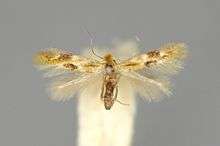Bucculatrix ulmella
Bucculatrix ulmella is a moth of the family Bucculatricidae. It is found in most of Europe, except the Iberian Peninsula, Slovenia and Bulgaria. It was first described in 1848 by Philipp Christoph Zeller.
| Bucculatrix ulmella | |
|---|---|
 | |
| Scientific classification | |
| Kingdom: | Animalia |
| Phylum: | Arthropoda |
| Class: | Insecta |
| Order: | Lepidoptera |
| Family: | Bucculatricidae |
| Genus: | Bucculatrix |
| Species: | B. ulmella |
| Binomial name | |
| Bucculatrix ulmella | |
| Synonyms | |
| |
The wingspan is 7–8 mm.[3] Adults are on wing from May to June and again in August.[4]
The larvae feed on Castanea sativa, Quercus faginea, Quercus petraea, Quercus pubescens, Quercus robur, Quercus rubra and Quercus trojana. They mine the leaves of their host plant. The mine has the form of a short, angular corridor with much black frass and a large larval chamber. The larvae leave the mine and engage in lower-surface window feeding.[5] Larvae can be found in July and again from September to October. They are greenish grey mottled with white and with a light brown head.
Gallery
- Mined oak leaf
- Larva
References
- "Bucculatrix albedinella (Zeller, 1839)". Fauna Europaea. Retrieved 8 May 2019.
- Fauna Europaea
- UKmoths
- British Lepidoptera Archived September 16, 2012, at the Wayback Machine
- Ellis, W N. "Bucculatrix ulmella Zeller, 1848 oak bent-wing". Plant Parasites of Europe. Retrieved 8 May 2019.